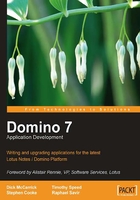
Chapter 3. Lotus Notes/Domino 7 and DB2
For years, Lotus Domino has provided flexible data storage using "self-describing" documents. This has allowed developers to add and remove fields from document types on the fly. Each document stored within a Domino database contains a list of fields and their values.
Domino Designer combines visual form design with a data definition tool that allows you to update the fields stored within a document type throughout the lifetime of the application. This often tempts developers to create tables of fields within a form. In a relational word this may seem sacrilege, but in Notes/Domino development, this is more often than not considered acceptable.
Domino 7 DB2 integration is a new feature (currently offered via "Limited Availability"; see the note below) that provides the opportunity to close the gap between document-centric Notes/Domino and relational, SQL-based DB2. It allows you to bring the scalability features of DB2 and the flexibility of SQL into Domino applications. This feature encapsulates the storage facility from both end users and APIs.
In this chapter, we examine how to configure Domino 7 to use DB2 as an alternative data store to the NSF format. We also look at two important concepts in Domino/DB2 integration:
- DB2 Access Views (DAVs), where selected data sets are pushed from Domino to DB2 in conjunction with a DB2 Access Server.
- Query Views, which are Notes views based on a SQL query. This design artifact is supported by the DB2 Access Server and a DB2 Access View.
The first release of Domino 7 and DB2 Integration is provided by IBM, solely for evaluation and testing purposes, with Limited Availability. It is currently unsupported. Further details can be found at http://www.lotus.com/ldd/d7db2.nsf. Full support for this feature will be provided in a later release. Consult the Notes/Domino 7 Release Notes to review the latest status.